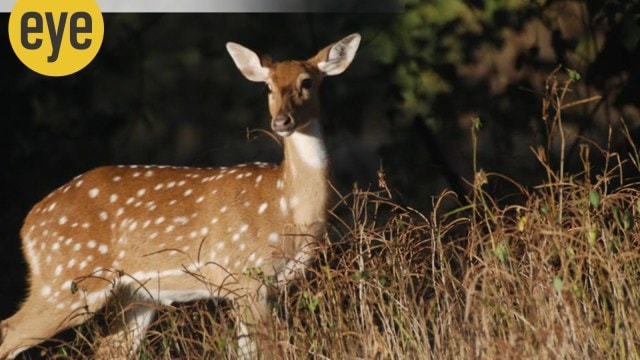Wildlife in the times of social media
If animals had social media profiles, what would their status say?
 A deer tiptoeing through a forest (Credit: Ranjit Lal)
A deer tiptoeing through a forest (Credit: Ranjit Lal)
If the denizens of Jungleland had social media profiles, what would their status look like? We take a look at who they are and how they behave:
Elephants: Gentle, sagacious five tonners, who are matriarchal, a true sign of their progressive way of thinking unlike the majority of us. Sentient, and can use and make tools with that all-purpose trunk, though with its 40,000 muscles, this is largely unnecessary. Highly protective of young, and will charge if you so much as glance at their babies while they are bathing. Some bulls, especially in Sri Lanka, have become highway robbers. We have treated them abominably, making them balance on beach balls wearing pink tutus (this is now mercifully banned), lead noisy drum-beating processions, take chattering tourists on safari rides, invading and destroying their habitats and migratory routes, and are now wondering why they seem so upset with us. They would just like to be left in peace, to waft through their forests, as silently as smoke… dropping dung-bombs in their wake and making dung-beetles ecstatic.
Rhino: Irascible, baby-faced and armour-plated, rhinos love to get down and dirty in the mud. They have a lovely bouncy gait (like horses) and a single horn (the Indian species), which in all our wisdom, we think can make us macho and virile. The ‘horn’ is basically hair – made of keratin – and why people in countries with populations exceeding one billion believe that hair can make them more macho and virile speaks volumes of their collective IQs.
Tiger: Our ‘national animal’ and for many of us, the only animal in the jungle worth looking at. After killing off 90 per cent of them in the past century, we are now spoiling them by providing unwell or injured beasts with easy prey (tethered bovines) and wondering why their progeny are doing the same thing, and even ungratefully lunging at us, instead of stalking chital. In Jungleland, we are nowhere near the top of the food chain – they are. They are ‘farmed’ in some Southeast Asian countries, their body parts consumed in the futile hope that we will become like them.
Lion: Gir in Gujarat is the only place where the Indian lion (aka Indian ‘loin’) lives, though they are now seemingly wanting to emigrate (like so many of us) in spite of the government’s insistence that they remain where they are. They’ve been shifting to adjoining areas and it will probably just be a matter of time before they apply for visas for neighbouring states or even the USA.
Leopard: These canny cats are slowly but surely moving into cities like Mumbai, where the broad-minded citizens have more or less accepted them as just another species trying to make it good in the country’s most cosmopolitan metropolis. Leopards trying to settle in bohemian places like Delhi are given short shrift by a hysterical population, trapped and carted away to the hinterlands. Notorious for eating dogs, they might change their diet if let loose in Delhi’s macaque-infested Northern Ridge where the monkeys have all but taken over the government.
Rhesus macaques: Those that still dwell in our forests, are shier, more respectful (especially of predators) and better behaved than the ‘goondas’ brought up in the cities; exactly the same thing that happens to us. Live your life in a quiet green hill-station (if one still exists) and you will be quite a different (and nicer) person than if you had been born and brought up in one of our teeming, ill-tempered cities. Rhesus macaques have struck underhanded business deals with the banana sellers on Delhi’s Northern Ridge: They leave the sellers alone, but wait for customers to buy the bananas – and then move in. Everyone’s happy! The seller makes his money, the monkey gets its bananas, and the customers feel blessed. Only ragged street urchins competing for the fruit may get bitten.
Wild Boar: Bristly, pugnacious and very dangerous to crops: they can destroy a potato field in a single night and disembowel you if you object. So not popular with farmers and the cry is out to term them as vermin and that they be culled. Alas, allowing the ‘aam junta’ easy access to guns may result in the culling of even more people than what our traffic does, given our hyper-sensitive sentiments and wayward aim. We need more leopards and tigers in such areas to take care of the matter in the appropriate way.
Nilgai: Another nuisance species for the farming community and needs the same controlling mechanism as those for wild boars. These tall, blue-grey antelope make hearty meals for predators, but will give them a run for their money. And beware: if you get between a nilgai bull and his golden harem (as I once did), he will threaten you with violence!
Sambar and Chital: Alas, deer — despite their liquid, eloquent eyes — are always at the receiving end and must definitely suffer from hypertension. Forever in fear of becoming a tiger’s lunch or dinner, they tiptoe their way through forests. The stags only get riled up when there’s a harem to defend. That’s when they put their heads down (it takes two to tangle) and then are taken down by crouching predators.
Water Buffalo: Aka ‘buffelo’, huge beasts not unlike the domestic variety and very rare, usually wallowing in jheels in the Northeast. Unfortunately, they’ve been playing fast and loose with the domestic variety and zoologists are afraid that the ‘asli’ wild buffalo is swiftly being replaced by a hybrid variety. Whatever, you do not want to mess with those six-feet wide horns. Also, remember what happened when African wild bees were ‘hybridised’ with European honeybees. [More species coming next week]
- 01
- 02
- 03
- 04
- 05































